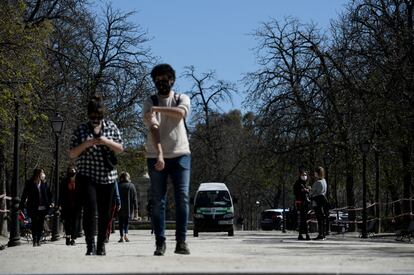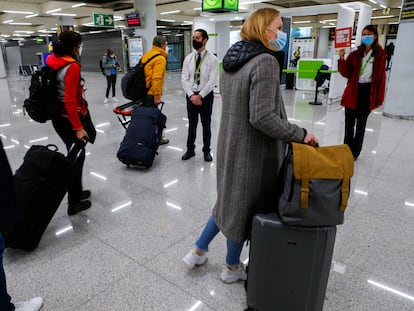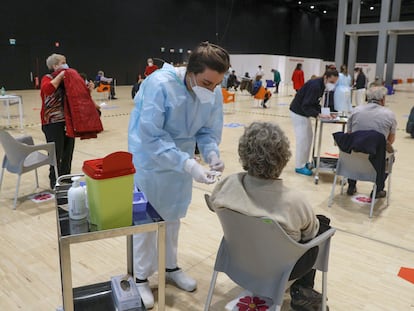Spain records 633 Covid-19 deaths since Thursday as experts warn of fourth wave
The latest figures from the Health Ministry suggest that either the epidemiological curve has flattened or the country is about to see a new spike in coronavirus cases

The Health Ministry’s daily coronavirus report added 633 Covid-19 deaths to the overall total on Monday, bringing the death toll since the health crisis began to 73,543. This high number, however, is partly due to the fact that no report was released on Friday, as it was a public holiday in parts of Spain, nor at the weekend. That said, the figure is still very high compared to the last two Mondays, when it came in at 166 and 298. When the seven-day figure for fatalities is looked at, and which offers a more accurate look at the trend, it is clear that this data point is worsening. On Monday it came in at 1,119, when a week ago it was 988.
The 14-day cumulative number of coronavirus cases per 100,000 inhabitants has also risen, in this case to 128.71. This figure has been on the rise for five days now, although due to the holiday on Friday and the weekend this has only been reflected in three reports. The rise seen on Monday compared to Thursday is only 0.54 points, meaning one of two things: that the curve has flattened and could fall once more, as the vaccination campaign takes effect and people continue to observe restrictions, or the feared fourth wave could be nearing.
We could be on the brink of a fourth wave, but that will depend on what we doElena Vanessa Martínez, president of the Spanish Epidemiological Society
It is now much easier to list the regions where the incidence is falling rather than rising: Asturias, Cantabria, Valencia, Madrid and Murcia, as well as the North African city of Melilla, which reported the same incidence on Monday as Thursday.
With the 16,741 new cases of coronavirus added to the figures on Monday the official total is now at 3,228,803 positives since the crisis began. Over the last seven days, the number is 33,741, which is the lowest of this third wave. A week before the number was 34,092.
Mondays are bad days to interpret the pressure on hospitals, given that the weekend – and holidays – change the pace in such healthcare centers. If the data from yesterday is compared with the last report, from March 18, it has worsened slightly. The occupation of intensive care unit (ICU) beds has risen from 19.52% to 19.54%, while usual hospital beds have gone from 6.27% to 6.43%.

The general situation, as is clear from these figures, is one of a plateau. But there is another data point to take into account: the cumulative incidence over seven days, which has also worsened – going from 61.47 on Thursday, to 62.53 on Monday. This parameter, which measures the most recent progress of the pandemic, would suggest that there will be no more major falls in cases for now.
With this situation, of three reports in a row with indicators on the rise but by very small amounts, there is no epidemiological manual that allows for predictions to be made about the future. That’s according to Elena Vanessa Martínez, the president of the Spanish Epidemiological Society (SEE). “We could be on the brink of a fourth wave, but that will depend on what we do,” she says. “My concern is that I have the sensation that we are seeing the same messages that we did at Christmas, with the result that we saw then,” she adds, in reference to the third wave that began at the start of December and grew over the holiday season. But “we still have time to avoid it,” she argues.
The Health Ministry added 16,741 new cases of coronavirus to the official total, which now stands at 3,228,803
To do so, Martínez says, it is essential that “activities be restricted.” “The risk is never zero, but the chance that there are more infections rises when the opportunities for risk do so too,” she says. The epidemiologist adds that “not everything that is permitted” by Spain’s regions, which are in charge of controlling the pandemic in their territories, is recommendable. “I would not open the inside of bars and restaurants,” she says. “Putting on your mask when you are not drinking or eating is complex. And the separation [of tables] of 1.5 meters, which I would raise to two meters, shouldn’t be measured between tables, because the chairs are then put in between and you end up close to the person next to you. It should be measured between people, even those at the same table,” she explains. “If you have to go to a bar, it should be outside and as far apart as possible.”
That said, the president of the SEE admits that if there is another wave, it will be less serious, and attributes this to a number of factors. The first is that the population group that is much more susceptible to getting ill and developing a serious illness is now vaccinated (i.e. residents of care homes, etc.). What’s more, according to surveys around five million people have had the virus, which will also make its spread more difficult. But there is still a problem with young people. “The ones who go out the most are not vaccinated,” she says in reference to this group. “What’s more, we know that they have a milder illness, but also that they acquire lower immunity,” she continues. “It has been seen that protection is greater the more serious the infection.”
Not even the Precov2 model, which has been created by the National Distance Education University (Uned) clears up this uncertainty about the future. Over the next two weeks, it predicts a completely flat curve for infections, with no rises or falls.
English version by Simon Hunter.
Tu suscripción se está usando en otro dispositivo
¿Quieres añadir otro usuario a tu suscripción?
Si continúas leyendo en este dispositivo, no se podrá leer en el otro.
FlechaTu suscripción se está usando en otro dispositivo y solo puedes acceder a EL PAÍS desde un dispositivo a la vez.
Si quieres compartir tu cuenta, cambia tu suscripción a la modalidad Premium, así podrás añadir otro usuario. Cada uno accederá con su propia cuenta de email, lo que os permitirá personalizar vuestra experiencia en EL PAÍS.
¿Tienes una suscripción de empresa? Accede aquí para contratar más cuentas.
En el caso de no saber quién está usando tu cuenta, te recomendamos cambiar tu contraseña aquí.
Si decides continuar compartiendo tu cuenta, este mensaje se mostrará en tu dispositivo y en el de la otra persona que está usando tu cuenta de forma indefinida, afectando a tu experiencia de lectura. Puedes consultar aquí los términos y condiciones de la suscripción digital.
More information

Spain to welcome German visitors over Easter break despite restrictions on national tourism
Últimas noticias
Most viewed
- Reinhard Genzel, Nobel laureate in physics: ‘One-minute videos will never give you the truth’
- Oona Chaplin: ‘I told James Cameron that I was living in a treehouse and starting a permaculture project with a friend’
- Pablo Escobar’s hippos: A serious environmental problem, 40 years on
- Why we lost the habit of sleeping in two segments and how that changed our sense of time
- The fall of a prolific science journal exposes the billion-dollar profits of scientific publishing









































